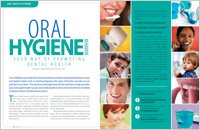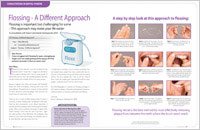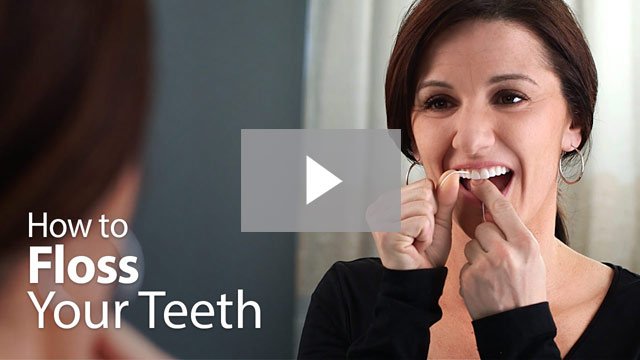Comprehensive Dental Examination
A comprehensive dental examination will be performed at your initial dental visit to Creative Dental Solutions. It will include the following:
- Examination for tooth decay. Tooth decay is not just a problem for children; as adults are living longer and keeping their teeth longer, decay remains a serious dental issue.
- Evaluation for gum (periodontal) disease. Periodontal disease causes bone to be lost around teeth and is estimated to affect up to 80% of the adult population in one form or another.
- Evaluation of necessary x-rays (radiographs). We use the latest in digital radiography, improving our diagnostic capabilities while reducing x-ray exposure 70-80% over film based techniques. Essential for detection of decay, abcesses, cysts, and bone loss, x-rays can also help us evaluate if you are a candidate for dental implants.
- Examination of existing dentistry; check current fillings, crowns, bridges, partial plates, and complete dentures. Although well done dentistry can last for years, there comes a time when replacement becomes necessary. Using special cameras, we can show you what we see and why we may recommend something new.
- Evaluation of the wear and cracking of teeth. The mouth is a harsh environment and the teeth take abuse. Options exist to fix what is worn and broken and protect what you now have.
- Cosmetic/Esthetic evaluation. Modern dentistry has many options to make your teeth and smile project the image you’ve always wanted.
Oral Cancer Screening
Your hygienist will check your face, neck, lips, tongue, throat, tissues, and gums for any signs of oral cancer. We have VELscope available at our Bangor office; VELscope is the the oral cancer screening system that uses fluorescence technology to identify suspicious areas.

Professional Dental Cleanings
Professional teeth cleaning in Bangor Maine at Creative Dental Solutions are performed by Registered Dental Hygienists. Dental cleanings actually include a range of services provided by our Dental Hygienists:
- Dental Prophylaxis: This is what is commonly called a dental cleaning. It involves removal of plaque, stain, and calculus (tarter) on the enamel surface and just below the gumline. It is the type of cleaning for patients who do not have periodontal disease. This is usually done every 6 to 12 months.
- Dental Scaling: If it has been a while since the teeth were last cleaned, it may be necessary to spend more time in removal of accumulated calculus/tarter before a Dental Prophylaxis can be done and may require a separate visit. Sometimes this is necessary before an accurate evaluation for periodontal disease can be performed.
- Periodontal Scaling and Root Planing: Once pockets form between the tooth and gum and bone is lost, periodontal disease has set in. More time is needed to address the cleaning needs of the periodontal patient. Sometimes, only a few teeth are affected by periodontal disease, other times most of the teeth are involved. Each patient is assessed for their specific needs and an appropriate plan to address those needs will be developed.
- Periodontal Maintenance: Once periodontal disease is under control, it is necessary to maintain the improvements. This requires a more frequent cleaning schedule due to the nature of periodontal disease. Recommendations are usually for maintenance visits every 3 months.
Dental X-Rays
Dental radiographs (x-rays) are essential diagnostic tools that provide valuable information not visible during a regular dental exam. We use this information to safely and accurately detect hidden dental abnormalities and to complete an accurate treatment plan. Without x-rays, problem areas can go undetected resulting in more serious issues at a later time.
Dental x-rays may reveal:
- Abscesses or cysts in the jawbone and around teeth.
- Periodontal bone loss around teeth.
- Cancerous and non-cancerous tumors.
- Decay between the teeth and under existing dental work.
- Developmental abnormalities such as missing or unerupted teeth.
- If there is enough bone for dental implants.
- Problems with the temporomandibular joint (TMJ)
- Problems inside a tooth or below the gum line.
- Detecting and treating dental problems at an early stage can save you time, money, unnecessary discomfort, and your teeth!
Are dental x-rays safe?
Dental x-rays produce a very low level of radiation. At Creative Dental Solutions, we take necessary precautions to limit the patient’s exposure to radiation when taking dental x-rays. These precautions include using lead apron shields to protect the body and using modern digital techniques that cuts down the exposure time of each x-ray 70-80% over film based techniques.
How often should dental x-rays be taken?
The need for dental x-rays depends on each patient’s individual dental health needs. We will recommend necessary x-rays based on the review of your medical and dental history, dental exam, signs and symptoms, age consideration, and risk for disease.
The American Dental Association (ADA) has published guidelines on the type and frequency of dental x-rays for specific patients’ age groups and risk categories. Creative Dental Solutions follows the ADA guidelines, with the most recent guidelines being published in 2012. Feel free to ask for a copy of these guidelines.
A full mouth survey using dental x-rays is recommended for new patients. This may include a series of individual x-rays, a panoramic x-ray, or a combination of the two. A full mouth survey is usually good for two to five years. Bite-wing x-rays (x-rays of top and bottom teeth biting together) are taken at varying intervals after having a full mouth survey and is based on a patient’s individual needs. For children, the interval may be every 6 to 12 months. For adults, the interval may be every 6 months, but is more commonly every 12 to 36 months depending on their dental history.
Home Care
A beautiful, healthy smile that lasts a lifetime is our ultimate goal when treating patients. Your personal home care plays an important role in achieving that goal. Your personal home care starts by eating balanced meals, reducing the number of snacks you eat, and correctly using the various dental aids that help control the plaque and bacteria that cause dental disease.
Tooth brushing - Brush your teeth at least twice a day (especially before going to bed at night) with soft bristle brush and toothpaste.
Place the brush at a 45-degree angle to the gums and gently brush using a small, circular motion, ensuring that you always feel the bristles on the gums.
- Brush the outer, inner, and biting surfaces of each tooth.
- Use the tip of the brush to clean the inside of the front teeth.
- Brush your tongue to remove bacteria and freshen your breath.
- Electric toothbrushes can be very helpful. They are easy to use and can remove plaque efficiently. Simply place the bristles of the electric brush on your gums and teeth and allow the brush to do its job, several teeth at a time. There are a number of electric brushes available today. We can help you decide which is the best one for you. We have available a number of different types of what we consider to be the best choices at prices typically below retail. Ask us to show you!
Flossing - Daily flossing is one of the best ways to clean between the teeth and under the gumline. Flossing not only helps clean these spaces, it disrupts plaque colonies from building up, preventing damage to the gums, teeth, and bone.
Take 12-16 inches (30-40cm) of dental floss and wrap it around your middle fingers, leaving about 2 inches (5cm) of floss between the hands.
Using your thumbs and forefingers to guide the floss, gently insert the floss between your teeth using a sawing motion.
Curve the floss into a C shape around each tooth and under the gumline. Gently move the floss up and down, cleaning the side of each tooth.
Floss holders are recommended if you have difficulty using conventional floss.
There are other methods for cleaning between the teeth that include special brushes, wooden and plastic picks, rubber tips, and water piks. We will help you find the best methods for cleaning between your teeth.
Toothpastes - Do you wonder which toothpaste is right for you? With so many choices on Bangor store shelves today, it is confusing. There are many good products available, along with products you should avoid that can damage teeth or cause sensitivity. There are the common over the counter toothpastes, professional products available only through a dental office, and prescription level products. Let us help you decide which product is best for you.
Rinses/Mouthwashes - There are a number of mouth-rinses available today. They can be helpful for control of gingivitis, bad breath, and tooth decay. Let us help you decide what could benefit you.
Related Oral Hygiene Articles
 Oral Hygiene – Dental Health for Life
Oral Hygiene – Dental Health for Life
The best tools for maintaining your oral health and minimizing dental problems are a quality toothbrush, toothpaste, a roll of dental floss, approved mouthwash and good diet. Unfortunately, myths and folklore abound on how and what to use to best effect. This article cuts through the confusion with a winning game plan for oral health… Read Article
 Dental Hygiene Visit
Dental Hygiene Visit
Each dental hygiene visit begins by reviewing your health history to identify issues that may necessitate special precautions during dental hygiene care to ensure your safety and to prevent medical emergencies… Read Article
 Flossing - A Different Approach
Flossing - A Different Approach
Flossing is important but challenging for some - this approach may make your life easier! Research suggests that while most people will habitually brush their teeth, developing a flossing habit is still a bit more difficult. Flossing however, remains the best method for most effectively removing plaque from between the teeth where the brush won’t reach… Read Article












